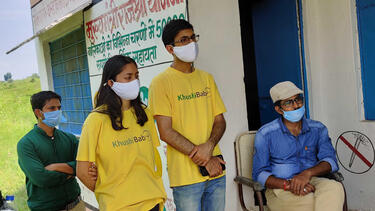Can Social Entrepreneurship Complement Public Health Systems?
While social entrepreneurs are often criticized for building parallel systems alongside public institutions, writes Yale SOM’s Teresa Chahine, in the case of public health they can serve as a pathway to strengthen and complement the existing public health system, especially in low-resource settings.
Social entrepreneurs help solve social problems with an entrepreneurial mindset and skill set. In countries like India where the public health system is under-resourced and unable to keep up with its citizens’ needs, social entrepreneurs are stepping in to mobilize resources in innovative ways and provide social services directly. Famous examples include Aravind Eye Care Systems, which tackled blindness in rural India by providing high-volume, low-cost eye surgery with differential pricing to cross-subsidize low-income patients. Aravind generates enough revenue to be self-supporting by charging more to people who can afford to pay and has performed tens of millions of cataract operations since 1976.
However, public health experts worry that the benefits of social entrepreneurship come with a risk: creating parallel systems that take away attention and resources from the existing public health system, rather than investing in strengthening that system. This is a legitimate fear, especially if social entrepreneurs are not able to engage and coordinate with existing public health systems in their countries.
The question becomes, how can social entrepreneurs create value in a way that complements the public health system? At first glance, primary care doesn’t seem like a likely candidate for social entrepreneurs. Compared to specialized services like eye surgery, primary care services are not uniform enough to benefit from a differential pricing model. In a recent study, Dr. Lutfi Lokman and I examined the kinds of business models used by social entrepreneurs providing primary health care services in low and middle income countries (LMICs), and found that instead of cross-subsidizing across patient segments, they have found ways to cross-subsidize across different services.
For example, the organizations found that adding additional services in their clinics, such as diagnostics and optometry, can help subsidize clinical consultation. Health information technology (HIT) was also a cited key to reaching underserved patients. Some of the social enterprises built their own in-house patient management software systems, which decreased their administrative burden, and allowed them to serve patients at different sites. A few were also able to sell their software to other providers, generating additional revenue streams to support their clinical consultations. HIT also allowed for the use of telemedicine, to reach remote areas. Many of these social enterprises were young, having been formed less than 10 years ago.
When asked whether they were able to engage with the government to complement existing public health systems, many replied that they found it frustrating to build a relationship with authorities like the ministry of health. However, one of the social enterprises, which had been around the longest, had found ways of adapting its services to complement the public health system. The organization’s main operations during initial establishment was providing primary-care services directly to underserved patients; over time, as it engaged with the public sector, its focus shifted, tailoring services around the greatest needs of the public health system. Today, alongside providing primary care services, this organization focuses on shortening wait times for diagnostic procedures with backlogs in public facilities, by providing those procedures and referring patients back to the public sector for continued care. This level of engagement was described by a top-level executive as taking a large amount of time and effort to build trust: “After a long time, we start to have trust from the mayor, the secretary [of health], the [public sector] doctors. They started saying, ‘You know, this [social enterprise] is very interesting, I think they can do more.’”
Engaging with the public health system over the long term is a commonly cited challenge among social entrepreneurs innovating public health solutions. Khushi Baby, a social enterprise originally developed by students at Yale and the subject of a case study in my Public Health Entrepreneurship course, is reimagining health records for the last mile. The organization’s core product is the longitudinal mHealth platform for primary health center medical officers, sub-center level auxiliary nurse midwives, and village-level accredited social health activists in Rajasthan, India. Initially, despite a strong district-level relationship, Khushi Baby struggled to gain government support and scale their immunization tracking platform beyond the pilot site in the city of Udaipur.
Collaborative entrepreneurship requires both partners—the government and the social entrepreneur—to share the burden of finding ways to build trust over time.
Over time, thanks to results showing the impact of mHealth on infant vaccination rates and a willingness to adapt their solution to meet state-level requirements, the team built trust with local community and district governments and was able to establish a long term partnership with the state government. Six years after this initial innovation, Khushi Baby was appointed the Nodal Technical Support Partner to the Department of Medical, Health, and Family Welfare for the Government of Rajasthan.
The team now is working to develop a digital community health platform which integrates a variety of aspects of public health. The team’s hope is to see state-driven innovations adopted into the central government’s overall framework, as they shared in a recent post on tracking COVID-19 vaccination in India.
Public health systems in many countries are operating in a resource-constrained environment. Social entrepreneurs can help mobilize scarce resources. Collaborative entrepreneurship requires both partners—the government and the social entrepreneur—to share the burden of finding ways to build trust over time with effective communication, consideration for contextual factors, careful selection of team composition, a focus on results and tangible outputs, and alignment of values. (Read our recent research on building trust in public-private partnerships in public health.)
As the world turns its attention to the important role that public health has to play in building thriving societies and a healthy planet, social entrepreneurship can serve as a bridge between government agencies and the much-needed resources available in the private and philanthropic sectors.
